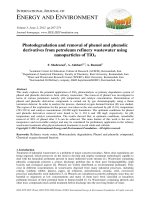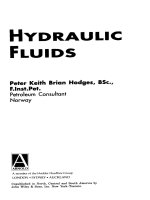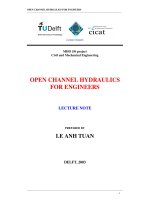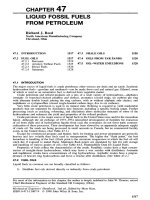Hydraulic fluids petroleum consultant norway
Bạn đang xem bản rút gọn của tài liệu. Xem và tải ngay bản đầy đủ của tài liệu tại đây (8.02 MB, 181 trang )
HYDRAULIC
FLUIDS
Peter Keith Brian Hodges, BSc.,
F. Inst. Pet.
Petroleum Consultant
Norway
ARNOLD
A member o f the H d d c r Hcadline Group
LONDON SYDNEY AUCKLAND
Copublished in North, Central and South America by
John Wiley & Sons, Inc. New York-Toronto
First published in Great Britain in 1996 by
Arnold, a member of the Hodder Headline Group,
338 Euston Road, London NW1 3BH
Copublished in North, Central and South America by
John Wiley & Sons, Inc.,
605 Thud Avenue,
New York, NY 101584)012 USA.
0 1996 P.K.B. Hodges
All rights reserved. No part of this publication may be reproduced or
transmitted in any form or by any means, electronically or mechanically,
including photocopying, recording or any information storage or retrieval
system, without either prior permission in writing from the publisher or a
licence permitting restricted copying. In the United Kingdom such licences
a r e issued by the Copyright Licensing Agency: 90 Tottenham Court Road,
London W1P 9HE.
Whilst the advice and information in this book is believed to be true and
accurate at the date of going to press, neither the author[s] nor the publisher
can accept any legal responsibility or liability for any errors or omissions
that may be made.
British Library Cataloguing in Publication Data
A catalogue record for this book is available from the British Library
Library of Congress Cataloging-in-Publication Data
A catalog record for this book is available from the Library of Congress
ISBN 0 340 67652 3
ISBN 0 470 23617 5 (Wiley)
Typeset in lO/lZpt New Century Schoolbook
by J&L Composition Ltd, Filey, North Yorkshire
Printed in Great Britain by J.W. Arrowsmith Ltd, Bristol
and bound by Hartnolls Ltd, Bodmin, Cornwall
GLOSSARY
Acid number
Additive
Adiabatic
Air entrainment
Aromatic
ASTM
Base oil
Bulk modulus
Boundary lubrication
Cavitation
Total acid number (TAN) or neutralization value. Quantity of base, expressed
in milligrams of potassium hydroxide,
required to neutralize the acidic constituents in one gram of sample fluid.
Supplementary component modifying or
improving fluid performance.
Isentropic. Compression or expansion
without heat being lost or taken up by
the fluid.
Dispersion of air bubbles into a circulating fluid, i.e. formation of an air-in-fluid
emulsion.
Chemical compounds with a molecular
structure incorporating the cyclic C6
benzene molecule.
American Society for Testing and Materials. A standardization association.
A fluid, e.g. mineral oil or a synthetic
fluid, without additives.
Reciprocal of compressibility, normally
expressed in units of bar or megapascal.
Lubrication of sliding contacts under
conditions of high specific loading,
resulting in the thickness of the lubricant film and surface roughness of the
rubbing surfaces being approximately
equal.
Hydrodynamic
situation
wherein
vacuum cavities are formed momentarily and then collapse due t o violent
pressure changes. Usually accompanied
xii Glossary
Centipoise
Centistoke
Coefficient of friction
Compressibility
Density
Demulsibility
Detergency
DIN
Dispersancy
Elastomer
Emulsion
EP-additives
by high noise level and frequently associated with erosive wear.
Unit of dynamic viscosity, 1 CP = 0.001
Pa s.
Unit of kinematic viscosity, 1 cSt = 1
mm2/s.
Quotient of the normal load on a sliding
surface and the force required to move
the surface. May be determined as the
static coefficient (pe)as movement just
commences, or as the kinetic value ( p k )
under normal operating conditions.
Fractional volume reduction of a liquid
when pressure is applied.
Mass of unit volume of a substance,
symbol p , expressed in units of kg/l or
g/ml.
Ability of a hydraulic fluid to separate
from water.
Ability to remove surface deposits displayed by certain polar fluids and additives. Detergent materials normally
display a certain degree of dispersancy
(refer below), and vice versa.
Deutsche Industrienorm - industrial
testing and materials specifications
issued by the German standardization
association.
The ability of certain fluids and additives to disperse other materials, contaminants, etc., in the form of minute
particles throughout the base fluid.
A macromolecular material possessing
elastic properties. It comprises of certain thermoplastic materials and vulcanized rubber, utilized for seals and
flexible hoses. The commercial products
are manufactured from various synthetic rubbers and polymers, modified
by addition of fillers and other materials.
An intimate dispersion of one fluid
within another.
Chemically active (‘extreme-pressure’)
additives, generally based on sulphur
Glossary xiii
Ferrography
Flash point
Fluidity
Friction
FZG
Helical molecules
Homologues
Hydraulic medium
Hydrogen bond
and phosphorous compounds, utilized to
prevent catastrophic wear under heavily
loaded boundary conditions. They function by reaction with the metal substrate, forming surface films which
effectively prevent direct contact of the
underlying asperities. Anti-wear additives of relatively moderate chemical
activity are normally selected for use in
hydraulic fluids.
Laboratory technique for examining
wear particles involving progressive
separation of wear debris by passing
the fluid through a magnetic field of
varying density.
The lowest temperature at which the
vapour above a fluid can be ignited
under standardized test conditions.
Inverse of viscosity, the flow properties
of a fluid.
Resistance to motion when attempting
to slide one surface over another. Fluid
friction is the internal friction of a
liquid, i.e. the viscosity.
Forschungsstelle fur Zahnrader und
Getriebebau, Munich. Gear test rig to
evaluate anti-wear properties of lubricating fluids. Specification requirement
in many hydraulic fluid specifications,
e.g. DIN 51 524.
Molecules possessing a steric structure
resembling a spiral spring, e.g. certain
silicone fluids.
Chemical compounds possessing similar
general structures, but different molecular weights. Typical examples are propane, butane, pentane, hexane, etc.
Hydraulic fluid, usually hydraulic oil. A
liquid utilized to transmit hydraulic
energy.
A strong secondary chemical bond (2050 kJ/mol), and electrostatic intermolecular link between the hydrogen atoms
xiv Glossary
Hydrodynamics
Hydrokinetics
Hydrolytic stability
Hydrostatics
Induction period
Inhibitor
Isentropic
IS0
Isomers
Isothermal
Laminar flow
Lubricity
Neoprene
Neutralization value
in ‘associated’ liquids such as water and
alcohols.
Area of fluid mechanics pertaining to
the behaviour of liquids in motion.
Study of the energy of liquids in motion.
Ability to resist chemical reaction with
water. Inferior hydrolytic stability can
result in corrosion of susceptible metals
and filter plugging.
Area of fluid mechanics pertaining to
the energy of liquids under equilibrum
conditions and under pressure.
Initial period of time during oxidation of
a fluid prior to an exponential increase
in the oxidation rate.
An additive preventing or retarding an
undesirable effect, e.g. oxidation or corrosion.
See ‘adiabatic’.
International Organization for Standardization
Chemical substances of identical composition and molecular weight, but differing in molecular structure, e.g. butane
and isobutane.
Compression or expansion at constant
temperature, as opposed to the adiabatic process.
Streamline flow conditions in a liquid,
without turbulence.
Ability of a lubricant to reduce friction
between mating surfaces under boundary conditions and moderate specific
loads (‘oiliness’).
Polychloroprene (CR), synthetic rubber
characterized by excellent ageing properties. Frequently applied as the external coating during the manufacture of
hydraulic hoses.
Quantity of base, expressed in milligrams of potassium hydroxide per gram
sample, required to neutralize all acidic
constituents in the fluid. Equivalent to
alternative test methods reporting ‘acid
Glossary xv
Newtonian fluid
Oxidation stability
PAG
Particle analysis
Pascal
number’, ‘total acid number’ or ‘total
acidity’.
Liquids in which viscosity is independent of the shear rate.
Ability to withstand chemical reaction
with oxygenlair and subsequent degradation. Of prime importance at elevated
temperatures of operation.
Polyalkylene glycol (polyglycol), a class
of synthetic fluids.
Particle count, determination of the
number and size distribution of solid
contaminants in a fluid.
SI unit fox pressure, symbol Pa; 1
MPa=10 bar.
Pressure applied to a confined liquid at
rest is transmitted undiminished with
equal intensity throughout the liquid.
Type of additive preventing corrosion
and the catalytic effect of metals on
oxidation. Masks the normal electropotential of the metals by formation of surface films, e.g. sulphides and phosphates.
Degree of acidity or alkalinity. The
numerical value expresses the negative
exponent of the hydrogen-ion concentration in an aqueous solution.
Molecules in which there exists a permanent separation of positive and negative
charge, conferring a dipole moment to
the molecule. Of significance for the
adsorption of certain additives at metal
surfaces, e.g. corrosion inhibitors and
friction modifiers.
Substance of high molecular weight
formed by joining together (‘polymerizing’) a number of smaller units (‘monomer’) into large macromolecules. Typical
polymers are the viscous polymethacrylate resins utilized as viscosity index
improvers in hydraulic fluids.
Lowest temperature at which a fluid will
flow when tested under standardized
test conditions.
A’
?
Pascal’s Law
Passivator
PH
Polar substances
Polymer
Pour point
m Glossary
i
PPm
Rate of shear
Reynolds number
Scuffing
Seal compatibility
Specific heat capacity
Stick-slip
TAN
Parts per million, e.g. mg/kg or ml/m3.
Velocity gradient within a fluid. In a
fluid film between two sliding surfaces
in relative motion, the rate of shear,
expressed in reciprocal seconds, is
equal to flow velocity divided by the
thickness of the fluid film.
A dimensionless value equivalent to the
product of fluid velocity and pipe diameter divided by kinematic viscosity.
The resulting value is used as a criterion to differentiate between laminar and
turbulent flow conditions.
A serious wear mechanism involving
microwelding of asperities on contacting surfaces under conditions of high
pressure and high relative velocities.
The microwelding is followed by rupture of the welds, roughening and
increasing friction.
Ability of a hydraulic fluid and elastomer material to coexist in intimate contact without the elastomer displaying
signs of undue swelling, hardening or
deteriorating mechanical properties.
Quantity of heat required to raise the
temperature of unit mass of a substance
by one degree. Usually expressed in
kJ/kg per K or kcal/kg per “C.
Jerky relative movement between sliding
contacts under boundary conditions of
contact. This phenomenon prevails
when the static coefficient of friction is
higher than the kinetic value. Addition
of a friction modifier can alleviate the
problem by ensuring ps/pk
expressed in milligrams of potassium
hydroxide per gram sample, required to
neutralize all acidic constituents in the
fluid. Equivalent test methods report the
same property as ‘neutralization value’,
‘total acidity’ and ‘acid number’.
Glossary Ai
Thermal conductivity
Ability to transmit heat, normally
expressed in units of W/m per K.
Thermal stability
Measure of chemical stability when subjected to high temperatures, including
resistance to molecular scission, i.e.
‘cracking’. Regarding hydraulic fluids,
this property is principally a criterion
for the stability of additives.
Potential health hazards.
Toxicity
Measure
of
volatility,
normally
Vapour pressure
expressed in kPa, mm Hg or bar at a
specified temperature.
Resistance of a liquid to flow when subViscosity
ject to a shear force; the internal friction of a liquid. See also ‘centipoise’ and
‘centistoke’.
Readiness to evaporate; the majority of
Volatility
non-aqueous hydraulic fluids have extremely low vapour pressures.
Elastomer based on fluorocarbon polyViton
mers (FPM). Compatible with most
fluids up to =200”C and particularly
well suited in connection with synthetic
oils.
Wassergefahrungsklasse WGK, the German classification system
for assessing the potential toxicity of
products in the event of pollution of
waterways and lakes.
ZDTP or ZDDP
Abbreviation for the group of anti-wear
additives based on various zinc dialkyl(ary1)dithiophosphate compounds.
These additives also function, in varying degrees, as oxidation and corrosion
inhibitors.
INDEX
Acids, 24, 71, 82
Acidity, 74, 129, 134
Acid number, 111, 143
Additives, 22-29, 32, 67, 72, 80, 82,
146
Adiabatic, 84-85
Aeration problems, 83
AHEM, 110
filterability test, 91
Aircraft and Aerospace fluids, 102
Air release, 86-88
Air vent, 86
Alternative materials for sea water
operation, 151
Aluminium, 69, 138, 151
Amsler test, 117
Analysis of used fluids, 132, 143
Anodic passivators, 82
Anti-oxidants, 2S24, 72-77
Anti-wear properties, 25-26, 67
Aqueous fluids, 12-13, 36, 150
condition monitoring, 143
Aromatic hydrocarbons, 18
Aromaticity, 20
Aryl phosphates, 24, 68-69
ASTM, 110
silting index, 90
Autoignition temperature, 106
Automotive brake fluids, 144
Auto-oxidation. 72
Base fluids, 13, 17-21, 3 M O
Bernoulli's law, 9
Biocides, 137
Biodegradable fluids, 12,74,156-160
Boiling point, 145
Brake fluids, 144-148
Bulk modulus, 5-2,
83
Butyl rubber seals, 138, 140
Cavitation, 45, 48, 84
Centipoise, 42
Centistoke, 43
CETOP filtration test, 91
Chemical nature
of additives, 24-29
of mineral base oils, 1 S 1 9
of synthetic fluids, 3 1 4 0
Chlorotrifluoroethylene, 106
Classification of fluids, 13
Cleanliness, 120, 128
recommended levels, 127, 128
Coefficient
of friction, 28, 29
of volumetric expansion, 63
Compatibility, 13, 81, 90, 115, 139,
140, 141, 160
Compressibility, 55,
Condition monitoring, 132, 135, 143
Contamination, 120,
classification, 124, 125
Corrosion, 15, 81-82
inhibitors, 23-24
test methods, 114, 150
Damping fluids, 38
Dean & Davis, 49
Decomposition temperature, 25-26,
72
Defoamant, 2S24
Demulsibility, 7 W 1 , 85
Denison
filterability test, 91
specifications, 92
P46 axial piston pump wear test,
119
164 Index
Density, 62
correction coefficient, 63
Detergent, 13, 29, 81, 85, 142
Deterioration, 126
Development of hydraulic media,
11-14
Dielectric properties, 15
Diesel injector test, 51, 119
Diesters, 35, 159
DIN, 110
hydraulic oil specifications, 92,
94-95
Dithiophosphates, 24, 70, 129, 134
Drainage valve, 79, 86
Elastomers, 11, 13, 29, 115, 138, 144,
148
Emulsifiers, 80
Emulsions, 13, 137-140, 143
Energy conversion, 2
Energy-rich radicals, 73-74
Environment, 16, 156
Evaporation losses, 137, 142
Esters, 35-36, 146, 159-160
Falex wear test, 26
Ferrography, 132
Film strength, see anti-wear
properties
Filterability, 13, 14, 89-91
Filters, 81, 91, 127, 141
Filtration, 127
Fire point, 106
Fire resistance, 12, 40, 103-106
Fire resistant fluids, 137, 152
fluids for aircraft, 102, 106
comparative table, 106, 138
conversion of existing systems,
140
maintenance of, 141
monitoring programme, 143
Flash point, 111
test methods, 111
Flow
properties, 41-54
laminar, 10, appendix 1
turbulent, 10, appendix 2
Fluid
types, 11-13
coupling, 4
power transmission, 2-8
Fluorocarbon elastomers (Viton),
138, 140
Fluoroethers, 40, 106
Flushing procedures, 126, 130
Foaming characteristics, 86,88, 126
test methods, 112
Foam suppression, 23-24
Formulation of fluids, 14, 22
Four-ball wear test, 26, 69
Friction
coefficients, 148
modifiers, 28, 149
FZG test, 52, 68, 69, 92, 117-1 18
Galvanized surfaces, 81
Gas solubility, 83
Gear pumps, 45, 122
Gelatinous deposits, 38, 90
German hydraulic oil specifications,
68, 70, 92, 118
Glycols, 12, 33, 139, 143
Halogenated compounds, 13, 37, 40,
106, 107
Health hazards, 36, 107, 153-155
Heating limitations, 131
Heat transfer, 66
High temperature fluids, 23, 31-40,
71-72
Hose materials, 138
Hydraulic components, 13-14, 45,
86, 122
Hydraulic fluids
analysis of used fluids, 132-135,
143
classification, 13
cleanliness, 12&128
development, 12
efficiency, 45
fire resistant, 137
maintenance, 126, 141
military applications, 102
oxidation, 71, 129
requirements, 14
selection, 108
specifications, 92
Hydraulic systems
hydrodynamic, 4
hydrostatic, 3
Hydrogen
bonds, 65
embrittlement, 79, 121
Index
Hydrolytic stability, 26, 31, 36, 39,
160
test methods, 114
Incendiary gunfire test, 105
Induction period, 72-73
Inhibitors
corrosion, 23, 24, 82
foam, 24,86
oxidation, 23, 24, 72-77
wear, 25, 26, 67-70
Interfacial tension, 24
Isentropic bulk moduli, 56-59
International Standards
Organization (ISO)
classification of fluids, 13
test methods, 110
Isomeric hydrocarbons, 20, 72
Karl Fischer test, 116
Kinematic viscosity, 43
Laminar flow, 10,44
Loss by leakages, 131
Low temperature properties, 20, 31,
48,72, 93
pour point, 4W9, 111
viscosity, 9S101, 103-104
Lubricating characteristics, 15, 28,
4446, 67, 139, 148
Lubricity, 33, 39, 67 see also friction
modifier
Machine tools, 13, 15, 29, 127
Marine applications, 104-105, 107,
150
Metal passivaturs, 23, 74
Microbiological growth, 137, 143,
151,157
test methods, 157-158
Microfilter, 88, 126
Military
applications, 102
specifications, 104-105
Mineral base oils, 17
composition, 17-19
typical properties, 20
Mobile systems, 1, 92, 96, 128
Moisture, 78, 120, 126, 145
Motors, 2, 13, 15C151
Multi-metal compatibility, 13, 69
165
NAS 1648 cleanliness specification,
125
Naval vessels, 107
Neoprene seals and hoses, 138
Neutralization value, 76, 134
test methods, 111
Newtonian fluids, 43
Nitrile rubber seals, 11, 29, 138
Non-newtonian flow, 43
Oiliness additive, see friction
modifier
Oil/water emulsions, 12, 13,
137-140, 143
Operational temperature range, 46,
108-109,137-140
Organic esters, 32, 35-36, 158-160
Oxidation, 129
acidity curves for different
additive systems, 76
inhibitors, 23, 24, 72, 75-77
kinetics, 71
life as function of temperature, 72
reactions, 73-74
stability, 71-77
test methods, 112-113
variation of oxidation products
with time, 75
PAG, 32-34
Particle
counts, 126, 132
size distribution, 123-125
Particulate contamination, 120
Pascal’s law, 5
Permanent viscosity reduction, 27
Petroleum-based fluids, 16, 17,
2C21, 133, 138, 14S149,
108-109
Phosphate esters, 36, 102
as fire resistant fluids, 137
comparative fire resistance, 138
system conversion, 140
Phosphor-bronze, 69,119
Phosphorus additives, 24, 6S70
Physical/chemical properties, 110
Piping
pressure loss nomograms,
appendix 1 & 2
Reynolds number, 10
viscosity calculations, 47
166 Index
Pressure relationship with
viscosity, 52-54
Pumps
dynamic clearances, 122
test methods for fluids, 119
viscosity requirements, 45
Polymers, 30
Polymeric additives, 26
shear stability, 5&52, 119, 133
viscosity index improvers, 24, 26
Quality requirements, 13-16, 22, 92,
104-105, 108
Radiation resistance, 31, 40
Reliability, 126, 128
Reservoir, 85-86, 128, 141
Reynolds number, 10
Rustinhibitor, 23, 24, 81-82, 90
Rust,
formation, 23, 78, 81
test methods, 115
Seals, 13, 137, 138, 140, 148
Seal compatibility index, 115
Seal swell, 24, 29, 33, 103, 147
Secant bulk modulus, 56-59
Service life, 71- 77, 129, 132-135
Servo valves, 89, 129, 134
Shear stability, 27, 50-52
Shell Irus Fluid AT, 139
Shell Irus Fluid C, 142
Silicate esters, 38-40, 61, 103, 147
Silicone
fluids, 37,50,61-62,106,107,146-7
defoamant additives, 23, 86
Solubility of air, 83
Sonic shear test, 119
Specific heat capacity, 65-66
Specifications, 92-107, 144-145
Spectral analysis, 19, 74, 132, 133
Spontaneous ignition temperature,
106
Stick-slip conditions, 28
Stoke, 43,
Storage stability, 130
Strainer, 47, 86, 140
Streamline flow, 10, 44
Subsea, 32, 107, 150-151
Sulphur-phosphorus additives, 24,
26, 70
Super-refined petroleum fluids, 33
Surface tension, 24
Synthetic fluids, 23, 30-40, 72, 103,
158-160
Tangent bulk modulus, 58-59
Temperature, effect on viscosity,
49-50, 53
Temporary viscosity loss, 27, 51
Test methods, 110
Thermal conductivity, 65-66
Timken test for lubricating
characteristics, 117
Torque converter, 4
Total acid number, 111,129,135134
Toxicity, 36, 107, 153-155
Turbine oxidation stability test
(TOST), 74, 113
Turbulent flow, 10, 51, appendix 2
Urethane seals, 28
Valves, 13, 45, 71, 122, 131
Vane pump, 26-28,45,52,68,69,122
Vapour pressure, 15,37,39,136,138,
144
Viscometer, 110
Viscosity, 41
calculation of maximum values,
47
diagrams, 49
dynamic,42
IS0 classification, 44
kinematic, 43
limits for various types of pump,
45
pressure relationship, 52-54
shear susceptibility, 51
significance for hydraulic
efficiency, 44-45
temperature relationship, 4%50
recommended range of operation,
46
Viscosity index, 49
Viscosity index improvers, 24,
26-28, 51, 133
Viscous flow, 4 1 4 3
Viton seals, 138
Volatility, 20, 33, 34, 39, 136, 144
Volume changes, 55, 63
Walther equation, 49
Wassergefahrungsklasse (WGK),
159
index
Water
as hydraulic medium, 11, 150
contamination, 78-80, 90, 128,
130, 133, 145
test methods, 116
Water-basefluids, 12,78,136-139,150
Water-glycol media, 12,107,139,142
Water-in-oil emulsions, 12, 136, 139
Wear
abrasive, 121, 134, 142
adhesive (scuffing), 67,121
corrosive, 25, 78, 6S70, 128
167
counteraction by additives, 24,
25-26, 67-70
surface fatigue (pittinglspalling),
121,137
Yellow metals, 69
Zinc
additives, 25, 81,90
components, 138
dialkyl(ary1)dithiophosphate
(ZDTP), 25-26, 69,70
PREFACE
This book is a revised edition of the original Norwegian language
publication issued in 1994.
Today, hydraulics is a n indispensable sector of modern engineering
science. Enormous technological advances have been made since the
initial use of water as a hydraulic medium in Joseph Bramah’s press of
1795.
Despite the considerable number of publications dealing with
hydraulics, the vast majority are principally concerned with the
mechanical components and system design. Very few allot more than
a chapter or so to the functional fluids which, after all, are the energy
bearing media. In the following pages I therefore review the development of modern hydraulic fluids, discuss their physical/chemical properties in relation to operational requirements, and offer guidance
concerning suitable maintenance routines.
It is my hope that this book may contribute to a wider understanding of the various fluid types and their discreet application.
I must admit to a sometimes overwhelming temptation to include
additional data, documentation and discussion with respect to a
number of my own particular fields of interest. Fortunately these
urges were largely curbed by an exacting deadline, otherwise I would
probably still be preparing a perhaps more lucid and comprehensive
though unfinished text.
This foreword would not be complete without a sincere expression
of appreciation to the many people who have assisted me during the
preparation of the manuscript. Particular thanks to my previous
employer, Shell Norway; also to publisher Birger Mdbach and Dag
Viggo in Yrkesopplzering ans (Oslo) for invaluable assistance in printing the original illustrations. Last, but not least, I would express my
gratitude for the encouragement and forebearance of my wife and
friends during long periods dedicated to my PC alone.
Peter Hodges
Stabekk, Norway, 7th December 1995
CONTENTS
Preface
ix
Glossary
xi
CHAPTER 1
Introduction
1.1
1.2
1.3
Introduction
Basic principles of hydraulics
Energy considerations
CHAPTER 2
Types of hydraulic media
2.1
2.2
Historical
The ideal hydraulic media
11
11
14
CHAPTER 3
Mineral base oils
3.1
3.2
Composition of mineral oils
Chemical nature
17
17
18
CHAPTER 4
Additives
22
CHAPTER 5
Synthetic oils
5.1
5.2
5.3
Types of synthetic oil
Synthetic hydrocarbons
Polyethers
30
31
31
33
vi Contents
5.4
5.5
56
.
57
.
Organic esters
Phosphate esters
Silicones
Fluoroethers
35
3
6
37
40
CHAPTER 6
Rheology
61
.
6.2
6.3
6.4
6.5
Viscosity
Low temperature flow properties
Temperature dependence of viscosity
Shear stability
Pressure dependence of viscosity
41
41
48
49
50
52
CHAPTER 7
Compressibility
71
.
7.2
73
.
74
.
75
.
76
.
Secant bulk modulus
Tangent bulk modulus
Effect of air on bulk modulus
Low bulk moduli fluids
Density
Thermal properties
55
56
58
59
61
62
65
CHAPTER 8
Anti-wear properties
67
CHAPTER 9
Oxidation stability
71
CHAPTER 10
DemuIsibiIity
10.1 Protection against corrosion
78
81
CHAPTER 11
Aeration problems
1 . Diagnosis and treatment of aeration problems
11
83
87
Contents vii
CHAPTER 12
Filterability
12.1 Filterability test procedures
89
90
CHAPTER 13
Specifications
13.1 Requirements
92
93
CHAPTER 14
Hydraulic fluids for military and aerospace
applications
14.1 Aircraft and aerospace
14.2 Combat vehicles and artillery
14.3 Naval vessels
102
102
106
107
CHAPTER 15
Selection of a suitable hydraulic fluid
108
CHAPTER 16
Test methods f r hydraulic media
o
16.1 Physical-chemical properties
16.2 Mechanical testing
110
110
117
CHAPTER 17
Contamination
17.1 What impurities are involved?
17.2 Where do the impurities originate?
120
120
120
CHAPTER 18
Deterioration and maintenance
18.1 Flushing
126
130
CHAPTER 19
Analysis of used hydraulic oil
19.1 Interpretation of the test results
19.2 Condition monitoring and oil change
132
133
135
viii CONTENTS
CHAPTER 20
Fire-resistant fluids
20.1 Conversion of existing systems to fire-resistant fluids
20.2 Maintenance of fire-resistant fluids
136
140
141
CHAPTER 21
Hydraulic brake fluids
144
CHAPTER 22
Future perspectives
150
CHAPTER 23
Health and safety
23.1
23.2
23.3
23.4
23.5
Ingestion
Skin contact
Eye contact
Inhalation
Materials safety data sheet
153
154
154
155
155
155
CHAPTER 24
Hydraulic fluids and the environment
24.1 What is biodegradability?
24.2 Determination of biodegradability
24.3 Biodegradable hydraulic media
156
157
157
158
Bibliography
160
Appendix 1
161
Appendix 2
162
Index
163
INTRODUCTION
I . 1 Introduction
The word ‘hydraulic’ originates from the greek ‘hydor’ (water) and
‘aulos’ (pipe). The term ‘hydraulics’ is applied today to describe the
transmission and control of forces and movement by means of a
functional fluid. The relevant fluid mechanics theory concerns the
study of liquids at rest (hydrostatics), or in motion in relation to
confining surfaces or bodies (hydrodynamics). Hydraulic power transmission is the technique of transmitting energy by means of a liquid
medium. Liquids utilized for this purpose are termed hydraulic fluids.
Use of hydraulics is expanding, and consumption of hydraulic fluids
today constitutes a significant part of the world’s total consumption of
refined mineral oils, approximately 1 million tons per annum or
around 10%. Mineral oil-based products represent over 90% of all
hydraulic media; the remainder are various water-based fluids and
synthetic oils. At present the bulk of these products are naturally
utilized within the industrialized countries, but the demand for
hydraulic fluids is now growing rapidly in the developing countries
where vast future potential requirements exist.
Hydraulic fluids find innumerable applications in both static industry and mobile systems outdoors (transport equipment, excavators,
bulldozers, etc.). Around 7&80% of the total volume of hydraulic
fluids is utilized in static industrial installations. A certain amount
of the remaining volume must meet the particularly critical quality
requirements of specialized mobile systems in aerospace and military
applications.
2 Introduction
Fig. 1.1 Energy conversion in a hydrostatic system.
Fig. 1.2 Relative size of components.
The basic principle for hydraulic power transmission is illustrated
in Fig. 1.1, where the input of electrical or thermal energy is converted to hydraulic energy, which is again transformed back to
mechanical power for the output of the system.
Power transmission is effected by means of energy-convertingunits
capable of transforming mechanical and hydraulic energy at the input
Introduction
3
and output of the installation. A functional fluid circulates in the
hydraulic circuit, transporting ehergy between the input and output
units.
One of the major advantages of hydraulic transmissions is the
relatively moderate dimensions of the energy conversion units
(hydraulic pumps and motors) compared to energy converters in other
fields (Fig. 1.2).
The transmission of energy between fluid and conversion unit may
be effected in accordance with hydrostatic or hydrokinetic principles
(Figs 1.3 and 1.4).
1.1.1 Hydrostatic systems
Power transmission in a hydrostatic system is effected by means of the
pressure of the hydraulic fluid, principal components being:
e the hydraulic pump to create the required working pressure;
e the piping and flexible hoses conveying the fluid flow between
components;
valves of various types controlling the direction of flow, pressure
and volume;
e cylinders (‘linear motors’) converting fluid pressure to linear mechanical work, e.g. in a hydraulic press or to operate wing flaps on
aircraft;
hydraulic motors converting fluid pressure to rotary mechanical
work, e.g. for the driving wheels of forestry machines or marine
winches.
Fig. 1.3 A hydrostatic system.
4 Introduction
1 .I .2 Hydrodynamic systems
A hydrodynamic system consists in principle of a centrifugal pump
(‘impeller wheel’) accelerating the transmission fluid against the
inclined vanes of a turbine rotor (wheel). In the simple fluid coupling, kinetic energy is transferred from the circulating fluid and
converted to rotary power as shown in Figs 1.4a.
Torque converters function in a similar manner. However, in this case
a freely rotating stator is interposed between the impeller and turbine
wheel - the stator is a vaned wheel. When the driven impeller rotates,
the transmission fluid is circulated from its vanes to the turbine vanes,
passing outside the stator. In returning from the turbine to the impeller, it passes through the stator. In doing so the stator’s vanes accelerate the transmission fluid with increased energy via the impeller
back to the turbine. The energy increase or output torque is greatest
when the impeller is rotating at maximum speed and the turbine
wheel is stationary. Figure 1.4b illustrates the principle of the torque
converter..
Hydrostatic systems are the most widely applied form of hydraulics
today, typical applications being hydraulic presses, machine tools,
earth-moving machinery, hydraulic jacks and brake systems.
Hydrodynamic systems are used extensively for fluid couplings and
automatic transmissions in commercial vehicles, agricultural machinery and passenger cars.
Fig. 1.4 (a) Fluid coupling (power transmission by kinetic
(b) Principle of torque converter.
energy).
Basic principles of hydraulics 5
Fig. 15 Hydrostatic pressure.
.
1.2 Basic principles of hydraulics
In an open body of water, e.g. a lake, the static pressure at any point
below the surface is proportional to the depth and density of the
water: p = hpg (refer Fig. 1.5). At 10 m depth in water, the resulting
pressure is approximately 1 bar (100 kPa), whilst at the greatest
depths of the west Pacific ocean, pressures of around 1140 bar
(114 MPa) are recorded.
As long ago as ancient Egypt and Rome, a number of the fundamental laws concerning flow and equilibrum behaviour of liquids were
utilized in the construction of simple water wheels, irrigation systems
and water supplies. However, it was not before the 17th century that
Blaise Pascal laid the foundation for the further development of
hydraulic theory with his historic observation:
The pressure at any point within a static liquid is identical in all
directions, and pressure exerted on an enclosed liquid is transmitted undiminished in every direction, acting with equal force
on equal areas. (Pascal’s Law)
This condition is illustrated in Fig. 1.6, where a force F is impressed
on the confined volume of fluid by means of a piston of cross-sectional
area A. The resultant pressure is evenly distributed throughout the
liquid and is equivalent to the unit load on the piston, i.e. F/A. Here
we ignore the actual weight of the fluid which is normally of no
significance on the pressure side of a hydrostatic system (a 10 m
head of water is, for example, merely equivalent to 1 bar of pressure).
The fundamental principle for power transmission in a hydrostatic
system is shown in Fig. 1.7.
6 Introduction
Fig. 1.6 Even distribution of pressure in an enclosed liquid.
The pressure developed in the fluid by force Fl is Fl/Al, and this
pressure is transmitted unchanged (i.e. without pressure loss) to the
piston of surface area A2. The transmitted force F2 is therefore
identical to F1(A2/A1),
and can lift a similar load or perform an
equivalent quantity of other mechanical work. Assuming this force
Fig. 1.7 Energy transmission in a hydrostatic system.









